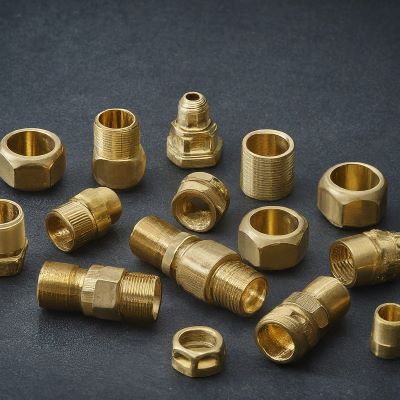The choice of fittings is a critical determinant of performance and reliability. Brass hydraulic fittings are a superior choice. They offer a harmonious blend of strength, durability, and corrosion resistance. As we explore hydraulic harmony, we discover its distinctive features. Brass hydraulic fittings are the preferred solution for seamless fluid connections. They are used in a variety of applications.
Discover the inherent advantages. Position brass fittings as a cornerstone in achieving hydraulic excellence.
What is the purpose of brass fittings?
In the intricate world of hydraulic systems, brass fittings are essential components. They facilitate the seamless flow of fluids. Their purpose is two-fold. They aim to establish secure connections between various hydraulic components. They also aim to withstand the demanding conditions of hydraulic applications.
Brass vs. Other Materials
A. Comparing Brass with Steel
Brass outshines steel in corrosion resistance. It is an ideal choice for hydraulic fittings.They are subjected to inclement weather and wetness. The formation of a protective oxide layer enhances durability.
In the weight-to-strength ratio, brass finds a balance that is advantageous. It offers robustness comparable to steel. It is lighter, contributing to overall system efficiency.
B. Advantages over Other Alloys
Aluminum
Compared to aluminum, brass excels in strength and durability. Brass is robust, so it’s better for applications that need resilience and longevity.
Stainless Steel
Stainless steel has corrosion resistance. Brass has a better mix of corrosion resistance, cost-effectiveness, and ease of machining. This helps it hold its ground.
Crafting Excellence: Manufacturing Brass Fittings
A. Precision Machining
The production of brass hydraulic fittings involves precision machining. This ensures every component meets exact specifications. This meticulous process guarantees tight tolerances. Tight tolerances are crucial for creating fittings that seamlessly integrate into hydraulic systems.
B. Quality Control Measures
Quality control is paramount in brass fitting manufacturing. We implement rigorous inspections and testing protocols. They verify dimensional accuracy, material integrity, and adherence to industry standards.
C. Compliance with Standards
Brass fittings manufacturers adhere to stringent standards. For example, they follow standards set by organizations like ASTM International. Compliance ensures that the fittings meet the performance and safety requirements. Compliance is essential for reliable hydraulic applications.
Types of Brass Hydraulic Fittings
A. Threaded Connectors
Threaded connectors provide a secure and leak-resistant connection. Their versatility makes them suitable for various hydraulic applications. They offer ease of installation and removal.
B. Flare Fittings
Flare fittings, with their cone-shaped surfaces, excel in applications requiring a tight seal. They find prominence in hydraulic systems where leak prevention is paramount.
C. Compression Fittings
Compression fittings offer simplicity and reliability. Their design involves compressing a ferrule or sleeve onto the pipe. This ensures a tight and secure connection without the need for soldering or welding.
D. Hose Barb Fittings
Hose barb fittings facilitate the connection of hoses to hydraulic systems. Their barbed design ensures a secure grip on the hose. It prevents leaks and ensures efficient fluid transfer.
Choosing the Right Brass Fitting
A. Considerations for Specific Applications
Selecting the right brass fitting involves considering the specific requirements of the application. Pressure ratings, temperature compatibility, and environmental conditions are crucial factors. They play a crucial role in making informed choices.
B. Sizing and Thread Types
Accurate sizing and matching thread types are vital for proper fitting selection. Mismatched sizes or incompatible threads can lead to leaks.This may jeopardize the hydraulic system’s integrity.
C. Compatibility with Fluids
Understanding the type of fluid the hydraulic system will handle is crucial. Brass fittings are compatible with a wide range of fluids. This makes them versatile and suitable for diverse applications.
What are the disadvantages of brass fittings?
While brass fittings offer numerous advantages, it’s essential to acknowledge potential drawbacks. These may include susceptibility to dezincification in certain environments. They also have higher initial costs compared to some alternatives.
Conclusion
In the hydraulic realm, the choice of fittings plays a pivotal role in the system’s performance and longevity. Brass hydraulic fittings stand out as superior components. They have corrosion resistance, precision craftsmanship, and versatility. They outshine other materials in specific aspects. They have a diverse range of fitting types. This makes them the go-to choice for hydraulic systems across various industries.
Understanding both the strengths and limitations of brass fittings is essential. It allows for informed decision-making when working with any material. This ensures hydraulic harmony in applications that need reliability and efficiency.
Post time: Feb-23-2024


